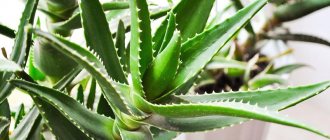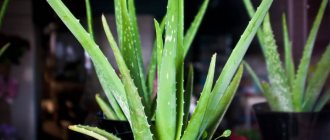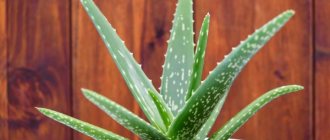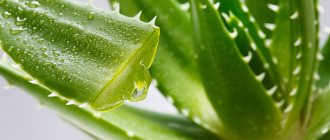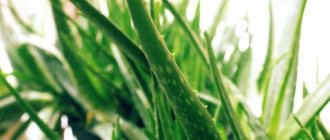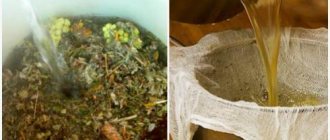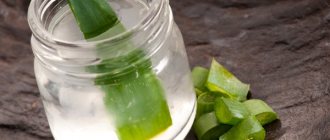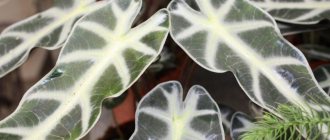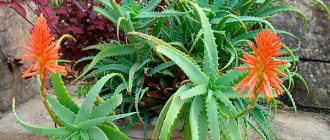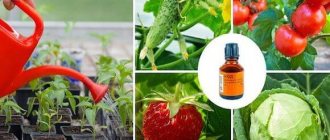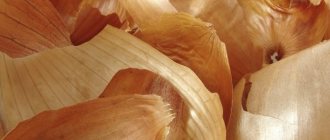What types of aloe are there: photos, names and descriptions of indoor varieties and medicinal varieties
The name aloe - aloe in Latin - probably comes from the Greek language, formed from the fusion of words meaning "giving" and "salt", indicating a bitter-salty taste. Transformed into Latin, it became aloë, “bitter.” It is quite possible that the original origin of the word is from the Arabic alloeh: “a substance that is bitter and bright.” A similar-sounding name, Ahal, appears in the Bible, suggesting linguistic roots in Hebrew.
The genus of aloe belongs to the Liliaceae family , according to the rules of traditional taxonomy, having previously been separated into the family of the same name. With the advent of the APG classification system, the plant began to be classified as Asphodelaceae. The genera Gasteria, Haworthia and Kniphophia have the same method of growth and are its closest relatives.
The succulent is often confused with a cactus, which is not surprising if you remember where its homeland is: Africa, Madagascar, the Arabian Peninsula. Various species of aloe are so widely cultivated throughout the world that it is impossible to identify its natural distribution area.
Aloe is a valuable plant. Its raw materials are rich in polysaccharides, allantoin, flavonoids, prostaglandins, phenol compounds, essential oils, choline, thiamine, cyanocobalamin, carotenes, ascorbic acid, potassium, zinc, copper, magnesium and other useful substances that determine its medicinal properties.
The Plant List, a joint development of Kew, the Royal Botanic Gardens in the UK, and the Missouri Botanic Garden, lists 558 aloe species, all of which are named in the project's lists.
The photo shows the types of aloe whose names are most widely known:
However, few plant species have medicinal properties. Only varieties of aloe derived from the species described below are classified as medicinal.
Aloe vera, which is real, rightfully takes first place. Used in gastroenterology for the treatment of gastritis, enterocolitis, gastric and duodenal ulcers; ophthalmology for complex therapy of keratitis, blepharitis, conjunctivitis, in cases of vitreous opacification; therapeutic cosmetology for sensitive and problematic skin; in folk medicine as an anti-inflammatory agent for mucous membranes and wound healing.
It grows in the southern half of the Arabian Peninsula, in Morocco, Mauritania, Egypt, the Canary Islands, Cape Verde, and the island of Madeira.
Its varieties, depending on their origin, differ in the color of the leaves (they can be blue or green). In addition, Aloe chinensis , the leaves of which are covered with white round spots.
Aloe arborescens , known as agave, was well studied in the mid-twentieth century. Its leaves and condensed juice (so-called sabur) are used to make laxatives, choleretic, anti-burn agents; they improve appetite and the secretion of the digestive glands.
Distributed in South Africa: Mozambique, Zimbabwe, Malawi, Swaziland.
Its subspecies known as Aloe arborescens var. natalensis has been tested in vitro since the 1980s, showing fungicidal activity and the ability to inhibit the growth of staphylococcus, streptococcus, diphtheria and dysentery bacilli.
These types of aloe have largely displaced its Socotrin variety, which came from the island of the same name in Yemen, but it has not lost its local significance.
The plant in the photo is an indoor variety of aloe flower:
Of course, no matter what types of aloe there are, they all have something in common in appearance. This is a typical succulent plant with thick, elongated leaves, most often arranged in the form of a rosette. Succulents are species that have special tissues to retain the moisture they need to survive in dry and hot climates. In extreme conditions, the plant will simply close the pores on the leaves so as not to lose a single drop of precious liquid.
The flowers of different types of aloe can be yellow, white, red or orange, but will always be tubular, located on a long peduncle. Alexander Kuprin, in one of his works, gives a very vivid description of the aloe flower: “Lush clusters of snow-white flowers of unprecedented beauty bloomed on the high green stem of the Agave, which emitted a wonderful, indescribable aroma that immediately filled the entire greenhouse.”
In all types of aloe, only mature plants bloom, and, in combination with developed leaves, which Vasily Botkin compared to protruding daggers, the spectacle is enchanting.
But not all types of aloe plant look the same. The appearance of the flower, the color and arrangement of the leaves are the diagnostic features that make it possible to distinguish different types of aloe and distinguish individual varieties from them.
For example, Aloe variegata (tiger aloe) has light transverse stripes “painted” on the leaves, and the leaves themselves are arranged one above the other in a tight spiral, but in the descuana variety the shades of the spots are bluish, and in the pearl variety they look like light growths.
The already mentioned agave is more reminiscent of a tree, for which it received its second name, the soapy one has leaves covered with a mosaic of pale spots, the ferox has a reddish tint, and the variegated one looks like exotic emerald marble.
Here are photos and names of indoor aloe species:
True, variegated and tree-like aloe vera take root best as a houseplant: they are the easiest to care for.
For decorative purposes, breeders develop hybrid varieties of aloe. The most popular of them:
Black Gem is a rosette plant of miniature plants that changes its leaves from bright green to red when exposed to sunlight for long periods of time.
Donnie - has variegated dark green foliage with pink edges.
Snow flake - leaves are almost completely white, with green shading.
Blue elf - derived from aloe squat, with blue-gray leaves and orange flowers.
Pink blush - distinguished by reddish-pink edging and shading on the leaves.
Christmas Carol - known for its bright red thorns on green leaves.
The presented photos show aloe varieties in all their diversity:
How to properly care for an aloe flower (with photo)
An alternative to a prickly cactus can become a pleasant ward for the owner, but how to properly care for an aloe flower?
Endurance and unpretentiousness are the main qualities due to which aloe does not require specific growing conditions. A native of Africa is not spoiled by air humidity: it tolerates dry air, even in apartments with central heating.
For the same reason, it does not require abundant watering: maintain moderate soil moisture; Water less in winter.
Important! Avoid stagnant waterlogging; it leads to damage to the root system, which will become noticeable no sooner than the rot rises up the stem to the leaves, and it will be difficult to save the plant.
Growing aloe at home requires selecting a suitable location: sunny, in summer it is best to place it outdoors in a protected place. Despite its southern origin, being a house flower, aloe does not approve of too high temperatures: room temperature, coolness is necessary in winter. Optimal conditions are 18-20 °C, then the plant will develop quickly.
In different countries, especially in the wild, each type of aloe grows in soil that is slightly different in composition, but, regardless of the variety, an alternative substrate is suitable for all of them: a flower soil mixture with 1/3 sand.
When preparing the soil yourself, you need to take into account that in nature the plant takes root on dry, clay soils with a high iron content and good aeration. Botanists speak well of a mixture of turf, leaf soil, humus and coarse sand.
Sections of turf soil are made on fertile plains (soil layer 7-10 cm thick), carefully monitoring the absence of unrotted inclusions of organic origin. Leaf soil is used as a leavening agent. Only rotted leaves are allowed in it: tougher and harder elements are removed. River sand is washed well before adding to the soil mixture.
Care for growing aloe at home: feeding and transplanting from pot to pot (with video)
Caring for the plant at home, the gardener provides it with additional feeding: in the summer, every 3 weeks he applies fertilizer for cacti. In nature, the renewal of the organic and mineral composition of the soil is ensured by rain, the influence of wind, and the vital activity of birds and animals; at home you will have to do this yourself.
Sooner or later, the flower will need to be replanted: adult plants, if necessary, are replanted, on average once every 2-3 years, young plants - once a year. Aloe replanting is required when the flower begins to grow out of its pot, so transfer it to a pot one-fifth larger than the previous one.
The best time for such events is spring and summer, when the plant will receive enough natural light and the optimal room temperature for it is maintained naturally.
When replanting a plant, its roots can be treated with charcoal: it is a natural antiseptic and will prevent the death of the flower if the root system is accidentally damaged or infected. Place a layer of sand or perlite about 5 cm thick on the surface of the substrate - this will prevent the lower part of the stem from rotting.
You can watch the process of caring for aloe at home in the video below:
Watering and lighting
Many gardeners are interested in the question of how to water aloe? In the summer, the succulent should be watered only after the top layer of soil has completely dried. The plant does not like waterlogging and can rot from abundant and frequent watering. How many times should you water aloe in winter? Watering in winter is done infrequently, once or twice every thirty days.
Important! For irrigation, use settled water at room temperature. The bush must be watered correctly, at the base of the stem. Water should not end up on the leaves during watering. Excess moisture can lead to rot.
Since the succulent is native to hot countries, the plant is accustomed to sunlight. For favorable lighting, aloe should be kept on the south or east side of the windows.
Planting and caring for an aloe plant at home: method of propagation by seeds
Experts in growing and caring for aloe distinguish three main methods of propagation: by lateral shoots, shoot cuttings or seeds; they are all applicable at home.
Growing from seeds is the most labor-intensive and painstaking method of propagating aloe, but with its help you can get a real collection of indoor aloe species, because many stores sell mixtures of different seeds. Sowing is done in the spring, in March-April, using small bowls and soil consisting of turf, leaf soil and sand in a ratio of 2:1:2. Water moderately as the seedlings dry out, after which the seedlings are transferred one at a time into small pots.
The soil in them consists of turf and leaf soil and sand in a ratio of 2:2:1, with the addition of charcoal or brick chips. After a year, the plant is considered mature.
It is recommended to treat aloe seeds before planting so that the young flower quickly adapts to home conditions and better accepts care. This can be done in three ways: using potassium permanganate, copper sulfate or boric acid, and aloe juice as a biostimulant.
The potassium permanganate solution for seed disinfection should be weak and pinkish in color. It will protect the shoots from pathogenic bacteria. You can add a little solution to the substrate for the same purpose, but guided by a sense of proportion, since potassium permanganate is a strong oxidizing agent and can burn the seeds if the concentration is exceeded.
Undiluted aloe juice acts as a nutritional cocktail for the seeds. It is mixed with beet or tomato juice, left for a day, after which a gauze bag with seeds is placed in this mixture. In a couple of hours they will be ready to land.
A solution of boric acid or copper sulfate will provide protection against parasites and fungal spores. Keeping the seeds in the solution for a quarter of an hour will provide effective disinfection, after which the seeds, washed with running water, are planted in the soil.
Best Aloe Vera on iHerb
Aloe vera supplements can be purchased on the iHerb website. This largest online store offers products from world manufacturers at very competitive prices; promotional code AEL3924 gives an additional discount. Shipping to many countries around the world is usually free on orders over $40, with home delivery over $60. Prices on the site are significantly lower than if you bought the goods in a regular store or pharmacy.
We will list the most popular options and immediately indicate general recommendations for use to discuss them with your doctor.
- Now Foods, Aloe Vera Gels, 250 Softgels. Take 2 capsules 1–2 times daily on an empty stomach. Equivalent to 10g pure aloe vera gel per capsule. Analogue, where the equivalent is 5 grams per capsule here and here.
- Nature's Way, Aloe Vera, Leaf Juice, 1 L. Take 30 ml. 2-3 times a day 5 minutes before meals. Enough for a month. After opening the package, the product should be stored in the refrigerator.
- Now Foods, Aloe Vera Concentrate, 118 ml. Take 1/8 teaspoon, stir in a glass of warm water, take on an empty stomach. After opening the package, the product should be stored in the refrigerator. There are 236 servings in a jar, a very profitable option.
- Lily of the Desert, 99% Aloe Vera Gel, 8 oz. Apply to the skin, 2-3 times per tap is quite enough, but more often is possible.
- Nature Republic Soothing & Hydrating Aloe Vera Gel (92%), 10.56 fl oz (300 ml). Apply to the skin, 2-3 times per tap is enough, but more often is possible. Inexpensive gel option.
Propagation of aloe flower by cuttings, top and leaf at home
Propagation of aloe by cuttings is faster and easier; this is one of the most popular methods.
It can be used all year round, but it is preferable to transplant aloe cuttings in the spring and summer, when it is easiest to provide the young animals with light and warmth at home. The cut shoots need to be dried for one or two days, then powdered with crushed coal. It will take away any residual excess moisture and disinfect the cut area. After this, the first planting is carried out - in wet sand to a depth of 1 cm.
After planting, the humidity level in the sand is maintained: it should not dry out, but it should not be flooded. There is no need to cover the plant, because it needs a constant flow of fresh air. By the seventh day, when roots form, the seedling is transferred to a pot where it will mature.
To propagate aloe from the top, it is carefully cut from the plant and placed in a vessel filled with water. Replant when the shoot forms several roots.
For the last method of propagating aloe - by leaf - the grower will have to carry out a small amputation at home. The leaf is completely separated from the stem near the base and removed in the shade until it dries. After this, the cut site is treated with charcoal and placed in a pot with a substrate to a depth of at least 3 cm - this is optimal for the speedy start of the rooting process.
Thus, planting and caring for aloe shoots is very simple, even in a home greenhouse. Regardless of the method of propagation and the type of flower, aloe does not make high demands on the owner.
Optimal soil composition, light, coolness and a balanced amount of moisture - that’s all the prickly doctor needs to turn green and delight the gardener’s eye.
Temperature
Aloe vera, unlike most houseplants, prefers contrasting day and night temperatures. The flower feels comfortable when the temperature on the thermometer in the room is from 18 to 22 degrees, but not higher than 30ºC. During the dormant period in winter, a coolness of 12 to 14 degrees is required, but not lower than 10ºC. The climate of most living spaces is suitable for the plant. If you send it to the balcony in fresh air for the summer, you should protect it from rain and drafts. By the end of autumn, it is necessary to promptly find a room with cool air for hibernation in ideal conditions.
Why do the leaves of an indoor aloe flower turn yellow and dry?
The photo shows a healthy indoor aloe flower:
However, despite all efforts, it happens that the pet begins to waste away. Let's look at the reasons for possible difficulties.
It was mentioned above that for optimal development of a flower, the soil in its pot must be periodically fed with cactus fertilizer.
Excessive depletion of the substrate will inevitably affect the plant: most often it is the answer to the question of why aloe leaves turn yellow.
Fertilizing is not carried out if the plant was replanted less than three weeks ago. During periods of prolonged rain, cool and cloudy weather, plants slow down their metabolism, so fertilizing should be reduced. The optimal composition of mineral fertilizers is considered to be with a high content of potassium, calcium and phosphorus - microelements that are essential for the health of the succulent.
If the grower misses the time for replanting, the root system becomes cramped in the pot, the development of the plant stops, and the supply of nutrients in the substrate is depleted. The flower begins to “lose weight,” that is, to draw out the necessary resource from its own external organs - this is why the tips of aloe leaves dry out.
In this case, you need to transfer outside the schedule. Do not water the plant for several days to make it easier to remove from the pot. If the roots have grown to the sides, the new pot should be wider. If the root system goes deep, you can take a pot of smaller diameter, but high. In the new container the plant should be free and spacious.
Another reason why aloe dries is not enough watering. The succulent wastes moisture without receiving the necessary amount to maintain the supply of fluid in the tissues, and the leaves begin to thin out.
Composition of Aloe
Aloe has a unique chemical composition - the plant juice contains about two hundred and fifty active biological substances. Aloe vera contains large amounts of vitamins and minerals, including vitamin A (beta-carotene), C, E, folic acid and choline, as well as antioxidants that help fight free radicals. Minerals such as calcium, chromium, selenium, magnesium, manganese, potassium, sodium and zinc are also present in small amounts to support your body's daily metabolic functions. Enzymes that help break down sugars and fats and reduce inflammation on the skin. The laxative effect of aloe vera comes from phenolic compounds known as anthraquinones. Meanwhile, the hormones auxins and gibberellins aid in wound healing and provide more anti-inflammatory benefits. Aloe contains seven of the eight essential amino acids needed to maintain healthy tissues and cells.
In terms of the content of useful substances, the juices of tree aloe and aloe vera are approximately the same, but it is generally accepted that the former is more successful in treating skin diseases, and the latter in treating diseases of internal organs.
Why does aloe still turn yellow if the soil is sufficiently fertilized and aerated?
As you know, the healthy green tint of plant foliage is due to the presence of chlorophyll, a pigment that helps carry out the process of photosynthesis. With its help, the flower feeds, develops - simply put, lives.
Photosynthesis occurs only in the presence of a sufficient amount of light for a given species: if the plant is too shaded, the metabolism is disrupted, the first symptom of which is a pathological change in the color of the leaves. You need to move the flower pot to a sunnier place, and over time the pigmentation will be restored.
In addition, being in an unfortunate place with limited access to light, the plant begins to reach for its source, which is another reason why the leaves and stems of aloe dry and weaken.
The color of the spots will help the grower make the correct diagnosis. Brown spots indicate a lack of moisture, as does a change in the elasticity of the leaves. If the spots are soft and dark, the flower is most likely affected by a fungal infection; you need to treat the leaves with an antiseptic.
Black spots indicate severe contamination; you need to wipe the plant from dust more often. Redness is a natural reaction to bright lighting, characteristic of agave plants; there is nothing to worry about.
If the leaves suddenly begin to fall off, the aloe was watered with too cold water. Keep the watering can in an area at room temperature, ideally close to the plant pot.
If the leaves wither, turn pale and look sickly, there is too much water in the ground. The watering regime must be changed as quickly as possible before the roots of the plant begin to rot. If the plant begins to turn yellow in the stem, stops growing and falls to one side, it has already contracted root rot. In this case, you need to remove the plant from the pot, inspect and remove all flabby and rotten roots, and cut them off.
Throw away the soil from the pot, wash and disinfect it. A mixture of peat and sand is poured into the pot, where the flower is planted for re-rooting. Water sparingly, using a tray, wetting only the bottom layer of soil. The next watering is not carried out until the soil is completely dry.
The amount of moisture is directly proportional to the temperature of the flower and the amount of sunlight.
If rot has affected the stem, the lower part of the flower is completely cut off until healthy tissue remains. The cut area is sprinkled with crushed coal, dries for 1-2 days, treated with Kornevin and planted as described above.
If small black dots are found on the leaves, the plant is affected by thrips, and the dots are traces of their excrement. The diseased flower is isolated and treated with actara according to the instructions. Repeat 4 times with breaks of 7-10 days. All house plants are given preventive maintenance.
If the green leaves begin to dry quickly, this means that the flower has developed dry rot. She is incurable. For prevention, the entire home collection is periodically treated with systemic fungicides.
